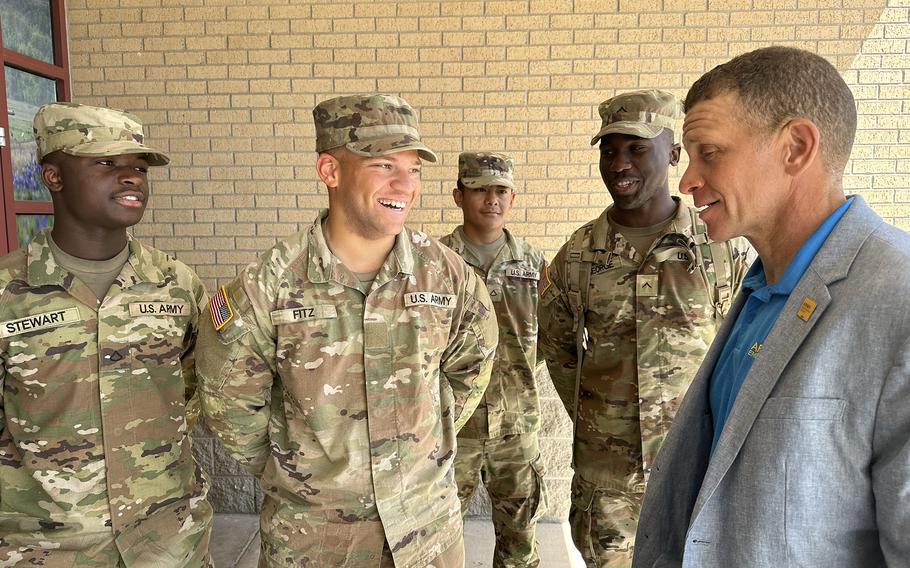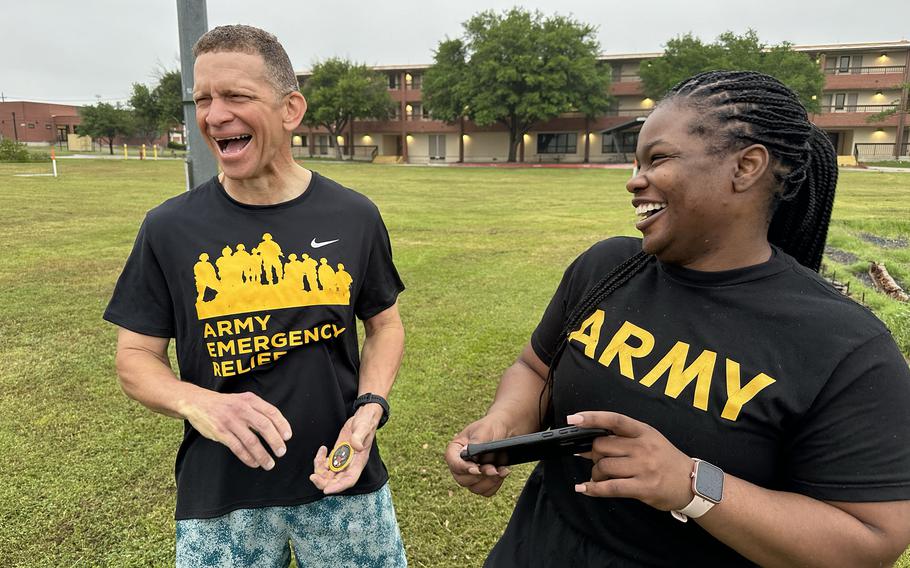
Tony Grinston, CEO of Army Emergency Relief and the 16th Sergeant Major of the Army, talks with soldiers new to Fort Cavazos, Texas, before eating at the installation’s OIF Dining Facility on April 22, 2024. Grinston was at Fort Cavazos for the first time after taking the lead of the U.S. Army’s official nonprofit in January to talk about leadership and the organization’s role in providing financial assistance to soldiers, retired soldiers and Army families. (Amanda Kim Stairrett/Army Emergency Relief)
AUSTIN, Texas — Tony Grinston may have retired from the Army as the service’s top enlisted member, yet in his new job as CEO of Army Emergency Relief, he’s still improving the lives of soldiers.
He’s been on the road since taking the job four months ago to visit Army bases and discuss AER, which provides interest-free loans and grants to soldiers in emergency situations and those needing help with costs for things such as healthcare that fall outside of military health insurance, funeral expenses, home repair or spouse licensing and recertification. It can also help soldiers obtain child car seats, clothing and child care. All assistance is considered on an individual basis and 5.5% of service members received assistance last year.
“When you hear about a soldier who stopped being able to pay their rent because they’re taking care of a family member — yeah, of course we are going to help them out,” he said during an interview this month while visiting Army Futures Command in Austin, Texas. “Not everybody gets to find a purpose in their life after the military. I found my purpose.”
While Grinston’s trips are to raise awareness of the support available through AER, it’s also indirectly about raising more funds, which could help Grinston’s pitch to the nonprofit’s board to transition more of the money AER offers to soldiers as grants instead of loans that must be repaid. Just 6.5% of soldiers donated to AER last year.
Grinston also wants to expand the support AER offers to Army Reserve soldiers. Right now, those soldiers only qualify when they’ve been on federal orders for at least 30 days.
Grinston is specifically focused on emergency travel grants that are given to soldiers who need to travel for an emergency family situation such as a medical crisis or death. Right now, soldiers are required to pay back half of the amount they receive.

Tony Grinston, CEO of Army Emergency Relief and the 16th Sergeant Major of the Army, reacts April 25, 2024, to watching a video created by Sgt. 1st Class Latoya Greene, a content creator stationed at Fort Cavazos, Texas. Grinston attended a group workout and professional development session led by Greene for soldiers of the 20th Engineer Battalion. (Amanda Kim Stairrett/Army Emergency Relief)
AER said it handled 5,500 emergency travel cases last year for a total cost of $5.5 million.
The amount provided can vary greatly, Grinston said. For example, airfare to get a soldier, spouse and children back to the U.S. from Germany following a death in the family is far more expensive but just as important as helping a single soldier drive home in a similar situation.
Traveling a couple of years ago in the wake of his own mother’s death led Grinston to push for the change, he said. As he and family were returning to Washington from Alabama, bad weather stranded them in Atlanta, forcing them to get a hotel.
“Imagine a young Army family just racking up the bills and putting it on a credit card. This is one of those categories that I’d really, really like to expand and just do more,” he said.
Last year AER received more than $2.2 million in donations and was able to provide soldiers $5.78 for every dollar donated. In total, soldiers received more than $38.6 million in loans, $7.8 million in grants and the organization provided $5.2 million in scholarships.
Grinston also plans to seek approval from the nonprofit’s board to expand access to Reserve soldiers regardless of orders.
“Why don’t we just make that a group that we help?” he said.
Down the road, he’d like to expand to the Guard, but Grinston noted many states have programs similar to AER to help out Guard members when they need financial help while on state orders.
“I can’t be out there [in the Army] anymore. I’m a little too old, but I’m still ready if the Army needs me,” he said. “At least I can somehow, some way make sure that if [soldiers] are going through a tough time, we can help them out with that.”